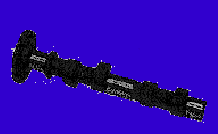|
| |



Cams, like heads, are a big area, you can really mess up an
engine with the wrong cam, even more so than with heads. A 1679 with Weber
34ICTs and standard heads will not run with an Engle FK98 cam.
Cams have two main measurements, the lift, in either millimeters or inches, and
the duration in degrees of the crank. The duration is the time the valve is
opened for, the longer this duration the more fuel gets into the engine and the
bigger the bang when it ignites. Well, that's the theory, in actual fact the
longer the valve is open for the faster the engine needs to be running for this
to happen, so at idle the engine will not run all that well. For street use you
should not consider anything with a duration of greater than 290 degrees. The
most popular cam this guy has ever seen used on the street is the Engle W110, it
has 286 degrees and 0.431" (10.95mm) valve lift. Engle also make the W100 which
is often better used on an engine under 1700cc or heavy weight cars (I use on in
my 1776cc crewcab). The duration of this cam is only 276 degrees which brings
the power band down where a smaller capacity engine needs it.
Remember this: The longer the duration the higher the power band, and
subsequently the lack of power in the lower rev range.
Cam lift is usually measured in inches ('cos most manufacturers of VW cams are
American, despite being for a German car, don't ask) and either is at the valve
or the cam, so make sure you know which before deciding on one. There are
different rocker ratios as well, the standard rockers multiply the lift by 1.1,
whereas others have ratios of 1.4:1 and 1.5:1, this of course means the cam lift
is multiplied by 1.4 or 1.5 to give full valve lift (less the rocker/valve
clearance, usually 0.004"/0.1mm for inlet and 0.006"/0.15mm for exhaust, keep
this to 0.006"/0.15mm for both on a <100bhp engine). If you intend using higher
ratio rockers, check the cam card closely and check if you can/should run a
ratio rocker with it. The more lift you have the more fuel goes in and the
bigger the bang when it ignites, so the higher the lift the more fuel (well, it
almost works like that). Most manufacturers have their popular street cams, I've
mentioned Engle's, Bugpack have their 4062-10, which gives a little less lift
and a little less duration, Scat have the C35, Gene Berg has his GB297, slight
differences, but all much the same. Any of these cams will work well on the road
throughout the rev range, plus give increased performance over the standard cam.
They all have around 284-286 degrees and about 0.415 - 0.451". If you want a
little more lift without the extra duration, this guys’personal road choice is
the Engle VZ25, but these do work better with modified heads.
If you insist in going over the 290 degree barrier, then it's your own fault
when it's a bit sluggish in town. Valve lift is not quite as bad, but please use
1.1:1 rockers as there are very few road cams that are designed to use a 1.4:1
or 1.5:1 that work any better than an equivalent one designed to run on 1.1:1
rockers. Still try to keep your total valve lift to below 0.500" as this is the
limit of a standard head. Forget the 1.25:1 rockers, they really don't give
enough extra for the price you pay.
There are adjustable cam gears available, don't buy one. You cannot set up the
cam better that it was manufactured. If the cam doesn't match the cam card it
came with it is either a faulty cam or a faulty cam gear, so take it/them back.
There are also straight cut gears, these prevent cam lash caused by the
synchromesh type gear, but as you won't be running dual valve springs, you won't
need these either, plus they are so noisy.
Dual valve springs are available to fit any head, don't buy them, you don't need
them for street use and they slow your engine down. Any extra work you make your
engine do, like open valves with more springs on than they need, will slow it
down. A new set of single springs is a good idea, as this will keep your valves
closed when they should be closed because twenty five year old springs don't
work as well as they did when they were new.
You can buy chrome-moly pushrods, don't. You can and should consider 'cut to
length' steel pushrods, these will return your rocker arm geometry back to the
way the factory made it, efficient.
Rocker arm geometry: This is getting the valve opening through the full swing of
the rocker arm. To set this up, you will need to get a soft spring the same size
as the valve spring (you can use the inner spring from a dual set) and fit it.
Make an adjustable pushrod, this is done by cutting an old pushrod in half,
removing about 2cms (3/4 inch) from one half, tap and inserting a length of M6
thread with a nut on it tight into one end and drill out the other half to 6mm
so the thread slips in.
You'll only need the case, cam, one cam follower, crank with one rod on, one
piston without rings, one cylinder and one head (obviously you can have an
almost complete engine, this is just the easiest way to do it). Reduce this
adjustable pushrod to its shortest. Assemble the part mentioned with no pushrod
tubes on. Set the rocker adjusting screw to half way, and extend the pushrod
until you have a valve clearance of 0.006"/0.15mm, turn the engine over until
the valve is half open (you will need a dial indicator for this), at this point
the rocker arm should be level with the head's rocker cover seat (valve top and
pushrod top are level). If not, adjust the pushrod and with rocker stand shims
and valve lash caps (if necessary) until it is level. Recheck and if OK you can
cut your pushrods. This guy used a lathe for this as he could get the rods to
finish better and be more accurate than using a say or pipe cutter.
When you come to push the ends in after having cut them to length, use a large
hammer and a pair of old cam followers. You will have eight of them floating
around after putting new ones in with your new cam. You must use new cam
followers with a new cam, and not just because the bloke selling you the cam
tell you to. Look after your cam and it will look after you (or was that
something else?).
You can buy hydraulic cam followers and large base followers, don't. There are
light weight followers, this guy has never used these, but there is no reason
you shouldn't spend your hard earned money on them. Like he said about not using
double valve springs, if you have lighter cam followers the engine will have
less to lift and also return to base a lot faster. This will be of benefit, but
you probably won't notice it.
There are many different valve types available, but use those that come with
your heads, they will probably be stainless steel and all in the price. For road
use you don't need sodium filled titanium valves at several hundred pounds a
set, or anything else too special.
When you install your cam do use the paste they supply with it, in fact splash
it on all over the cam and the follower bases, plus do run the engine as the
instruction says.
|




![]()